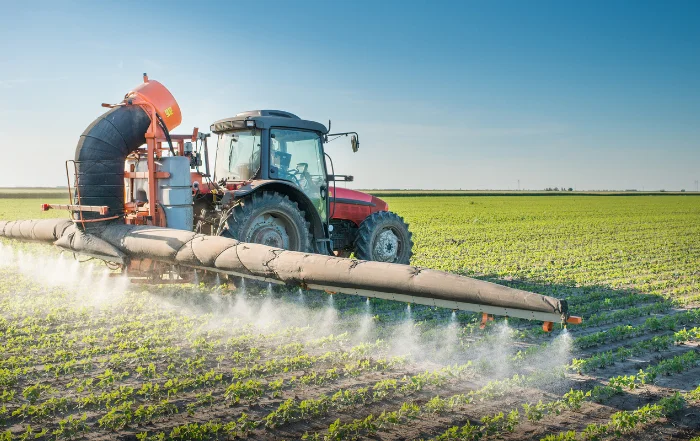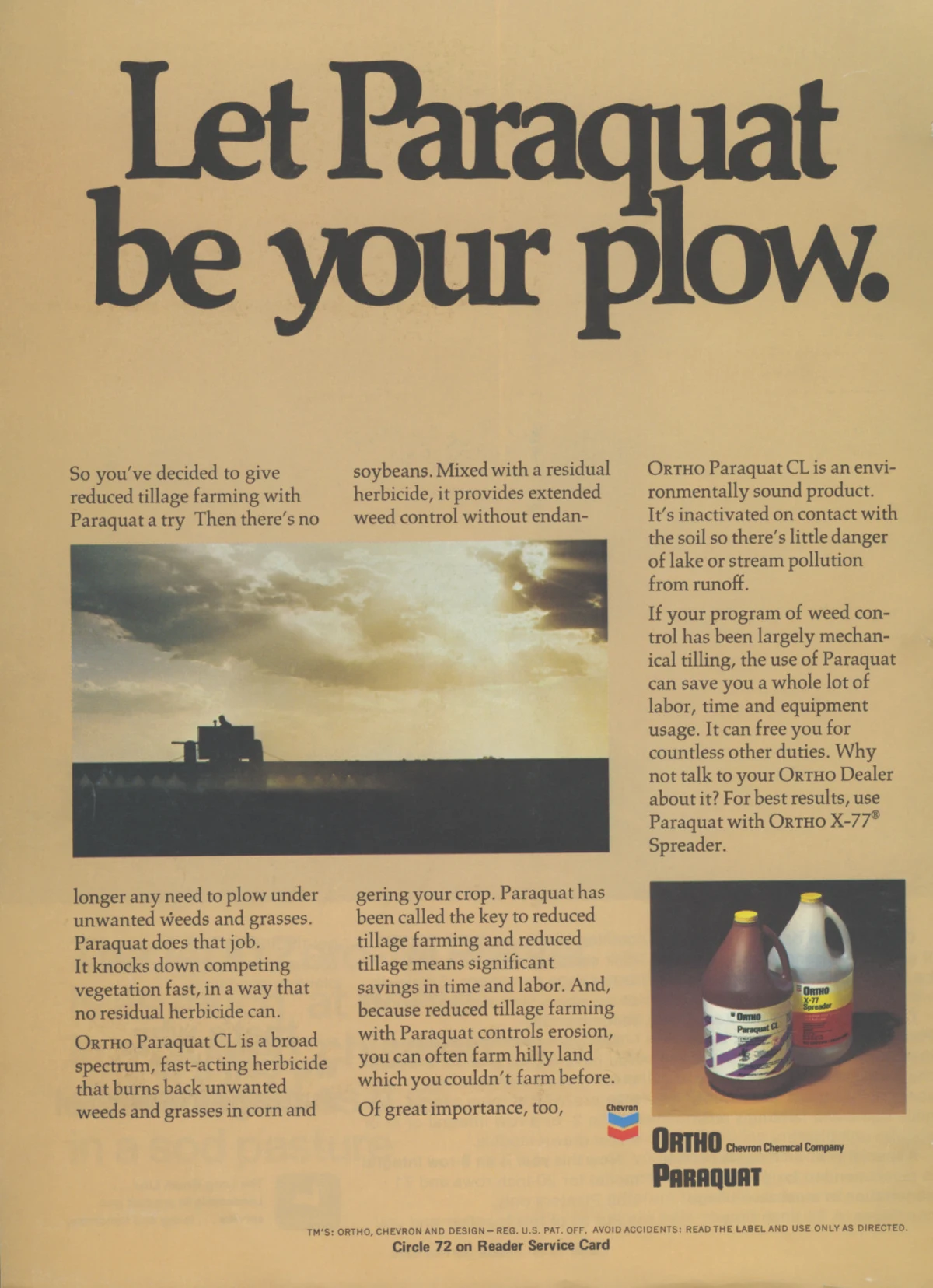Paraquat, once hailed as a revolutionary herbicide, is now facing mounting legal challenges and growing concerns over its safety. Thousands of farmers have filed lawsuits linking the chemical to Parkinson’s disease, while evidence suggests its toxic effects.
As the U.S. Environmental Protection Agency (EPA) reevaluates paraquat’s risks, the future of this deadly chemical hangs in the balance. This article delves into the history of paraquat, its widespread use in agriculture, its potential health risks, and the legal battles surrounding it.
The Rise of Paraquat
In the early 1960s, as soil degradation became a concern for farmers, Chevron, a major distributor at the time, introduced paraquat as a solution for “no-till” farming.
Paraquat was marketed as a toxicant that could eliminate weeds, replacing the need for plowing and preserving soil integrity. It gained popularity among farmers seeking alternatives to traditional tillage practices.
Chevron’s advertisements encouraged farmers to embrace paraquat as their new “plow,” touting it as a game-changer in agricultural practices.
No-Till Farming and Herbicides
No-till farming, a practice aimed at minimizing soil disturbance, is crucial for regenerative and climate-smart farming.
While some farmers adopt herbicide-free approaches like using roller crimpers to manage weeds, many rely on herbicides like paraquat to control weeds without tilling. Glyphosate (commonly known as Roundup) has become the herbicide of choice for most no-till farmers.
However, paraquat remains popular because it effectively kills glyphosate-resistant weeds. According to the U.S. Geological Survey, paraquat is one of the most widely used herbicides in the U.S., applied in large quantities to soybean, cotton, and grape fields.
The Deadly Nature of Paraquat
Paraquat stands out as the deadliest herbicides used in U.S. agriculture, as acknowledged by the EPA. Even a small amount can be lethal if ingested. Reports as early as 1983 linked paraquat to suicides and accidental deaths.
Furthermore, growing evidence suggests a connection between paraquat exposure and Parkinson’s disease, a progressive neurological disorder with no known cure.
Over 50 countries, including the E.U., U.K., China, and Brazil, have banned paraquat due to its recognized dangers to human health and life.
Background on the Corporate Players: Chevron and Syngenta
The development and distribution of paraquat were spearheaded by Chevron, a prominent multinational energy corporation, in collaboration with Syngenta, a leading agricultural chemical company. In the 1960s, as concerns grew about the degradation of soil due to excessive plowing, Chevron saw an opportunity to offer an alternative solution to farmers. They marketed paraquat as a revolutionary herbicide that could effectively control weeds without the need for extensive tillage.
Chevron’s advertising campaigns touted paraquat as a key component of “no-till” farming, emphasizing its ability to disrupt the process of photosynthesis and prepare fields without disturbing the soil. By positioning paraquat as a substitute for the plow, Chevron aimed to capture the attention of soil-conscious farmers who were seeking methods to preserve soil integrity and prevent another Dust Bowl-like disaster.
Over the years, paraquat gained popularity and became one of the most widely used herbicides in the United States. However, concerns about its potential risks to human health and the environment began to emerge. As evidence linking paraquat to Parkinson’s disease and other adverse effects grew, demands for regulatory action and legal accountability intensified.
Chevron and Syngenta, as the former chief distributor and lead manufacturer of paraquat, respectively, have faced mounting legal challenges. Thousands of farmers affected by Parkinson’s disease filed lawsuits against these companies, accusing them of withholding knowledge about the herbicide’s potential risks and failing to provide adequate warnings. The lawsuits have unearthed internal documents suggesting that both companies were aware of the dangers associated with paraquat as early as the 1960s.
The legal battles have resulted in the release of hundreds of documents that shed light on the historical context of paraquat’s development and marketing. This information has contributed to a growing body of evidence that links paraquat to Parkinson’s disease and underscores the urgency for stricter regulations and accountability within the agricultural chemical industry.
As the lawsuits progress, the spotlight has turned to the responsibility of Chevron and Syngenta in ensuring the safety of their products and protecting the well-being of farmers and farmworkers. The outcomes of these legal proceedings could have significant implications for the future of paraquat and the overall regulation of agricultural chemicals.
Legal Battles and Reevaluation
Over 3,000 farmers affected by Parkinson’s disease have filed lawsuits against Chevron, the former chief distributor, and Syngenta, the lead manufacturer of paraquat. These legal battles have revealed documents indicating that the companies were aware of the potential risks associated with paraquat since the 1960s.
The first bellwether trial is scheduled for October 2023, which could result in compensation for affected farmers. Additionally, over 100 cases in California state courts and numerous individual cases across the country contribute to the growing legal scrutiny.
The EPA's Review
The EPA’s analysis of paraquat’s risks is also under review. A lawsuit filed by Earthjustice challenged the agency’s interim reapproval of paraquat for another 15 years, citing its failure to adequately consider adverse effects and its dismissal of the link between paraquat and Parkinson’s disease.
Prompted by the lawsuit, the Ninth Circuit Court of Appeals granted the EPA’s request to revisit its analysis of the herbicide. The outcome could potentially lead to stricter safety guidelines or even a complete ban on paraquat.
The Human Toll

The impact of paraquat extends beyond the legal battles and regulatory scrutiny. Victims like Larry Wyles and Jon Cox, both farmers diagnosed with Parkinson’s disease, have experienced devastating consequences.
Wyles, once a thriving farmer, had to sell his land and face significant medical expenses, while Cox struggles with daily tasks due to the progression of his Parkinson’s disease. These stories highlight the human toll of paraquat and the urgency to address its potential dangers.
The Future of Paraquat
As the legal battles unfold and the EPA reevaluates paraquat’s risks, the future of this lethal herbicide remains uncertain. The outcomes of the lawsuits and regulatory decisions could have far-reaching implications for the agricultural industry and public health.
Farmers, environmental activists, and health advocates are pushing for stricter regulations or an outright ban on paraquat to protect human lives and the environment.
Alternatives and Sustainable Farming Practices
The controversy surrounding paraquat underscores the need for safer alternatives and sustainable farming practices. The agricultural industry is exploring innovative solutions that reduce reliance on hazardous chemicals and promote regenerative practices.
Integrated pest management (IPM) strategies, crop rotation, cover cropping, and mechanical weed control methods are gaining traction as effective alternatives to chemical herbicides. These approaches prioritize soil health, biodiversity, and long-term sustainability.
Public Awareness and Education
Raising public awareness about the risks associated with paraquat is crucial. It’s essential for farmers, consumers, and policymakers to be informed about the potential health hazards posed by this herbicide.
Educational initiatives can empower farmers to make informed choices about their farming practices and encourage consumers to support sustainable agriculture.
The legacy of paraquat is a troubling one, as it intertwines advancements in agricultural practices with significant health concerns.
The legal battles and regulatory reevaluation are shedding light on the potential risks associated with this deadly herbicide.
The outcome of these proceedings and the actions taken by regulatory authorities will determine whether paraquat remains a widely used agricultural chemical, or if safer alternatives and sustainable farming practices take its place.
Ultimately, protecting human health and the environment must be prioritized, ensuring a safer and more sustainable future for agriculture.





















